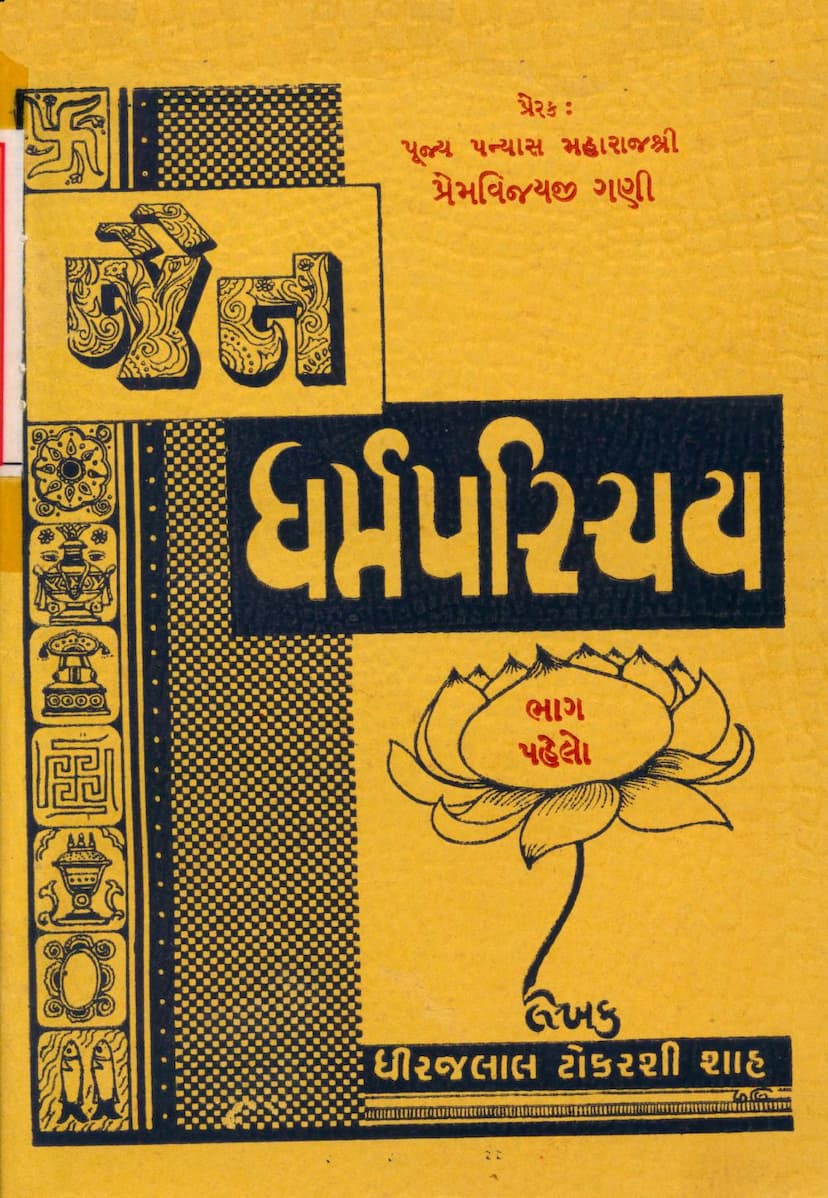Jain Ddharm Parichay Part 01
Added to library: September 1, 2025

Summary
Here is a comprehensive summary of the Jain text "Jain Dhara Parichay Part 01" by Dhirajlal Tokarshi Shah, translated into English:
Book Title: Jain Dhara Parichay Part 01 (Introduction to Jainism, Part 1) Author: Dhirajlal Tokarshi Shah Publisher: Vanechandbhai Avichal Mehta
This book, "Jain Dhara Parichay Part 01," serves as an introductory guide to Jainism, aiming to provide an authentic and concise overview of its principles and history. The author, Dhirajlal Tokarshi Shah, has compiled this work with the inspiration of Pujya Pannas Maharajshri Premvijayji Ganı.
The book begins by emphasizing the ancient and pure nature of Jainism, presenting evidence that it is an independent and original religion, not a branch of Vedic or a transformation of Buddhist thought. It highlights the contributions of scholars and historical findings that support Jainism's antiquity, dating it even before the Vedas. The text also touches upon the interconnectedness of Jainism with the ancient civilizations of the Indus Valley.
A significant portion of the book is dedicated to the life and teachings of Lord Mahavir Swami, the last Tirthankar. It clarifies misconceptions about his birth, lineage, and the historical context of his era. The book explains the concept of a Tirthankar as a spiritual guide who establishes the path of righteousness and liberation. It delves into Mahavir Swami's childhood, his renunciation, his rigorous ascetic practices, his attainment of Keval Gyan (omniscience), and his establishment of the four-fold Jain congregation (monks, nuns, laymen, and laywomen). Various events from his spiritual journey, including challenges and interactions with deities and individuals, are recounted to illustrate his profound spiritual strength, patience, and non-violent resistance.
The text then explores the Jain understanding of the universe and its order, detailing the concept of six eternal substances (Dravyas): Dharma (principle of motion), Adharma (principle of rest), Akash (space), Kal (time), Pudgal (matter), and Jiva (soul/consciousness). It explains how these substances interact to create and sustain the universe without the need for an external creator deity. The book clarifies the Jain view that the universe is eternal and has no beginning or end, operating through self-regulation and adherence to natural laws. It refutes the idea of a creator God, explaining that if God created the world, the question of God's creator and the purpose of creation would arise, leading to logical inconsistencies. Jainism posits that the highest beings, the Arihants and Siddhas, are worthy of worship and are considered Ishvar (God) in the sense of being supreme beings, but they do not control the universe.
A core philosophical concept of Jainism, Anekantavada (Many-sidedness), also known as Syadvada, is thoroughly explained. This doctrine asserts that truth is multifaceted and can be viewed from various perspectives. The famous analogy of blind men and an elephant is used to illustrate how each individual perceives only a part of the truth based on their limited experience. Anekantavada encourages understanding and tolerance by acknowledging that different viewpoints can coexist and that a complete understanding requires considering all sides. The book presents the seven-fold syllogism (Saptabhangi) as the logical framework for expressing these multiple perspectives.
The book then introduces the Nine Tattvas (Principles) of Jainism, which are fundamental to understanding the path to liberation:
- Jiva: The soul or consciousness, which is eternal, possesses knowledge, and is capable of experiencing karma and achieving liberation.
- Ajiva: Non-living substances, including Dharma, Adharma, Akash, Kal, and Pudgal.
- Punya: Merit or good karma, accumulated through virtuous actions, leading to happiness and favorable rebirths.
- Papa: Demerit or bad karma, accumulated through unvirtuous actions, leading to suffering and unfavorable rebirths.
- Asrava: The influx of karmic particles into the soul due to passions and unregulated senses.
- Samvara: The stopping of the influx of karma through self-control, restraint, and vows.
- Nirjara: The shedding of accumulated karma through asceticism and penance.
- Bandha: The bondage of the soul to karma, which determines its experiences and future births.
- Moksha: Liberation from the cycle of birth and death, achieved by eradicating all karma and realizing the soul's true, pure nature.
The text elaborates on the concept of Mithyatva (False Belief) and its detrimental effects on spiritual progress, categorizing it into various types. It then discusses Samyakatva (Right Belief) as the crucial first step towards liberation, emphasizing its importance in guiding one towards right knowledge and right conduct.
The book outlines the importance of Dharmacharan (Practice of Dharma), categorizing it into practices for monks (Sadhu Dharma) and householders (Grihastha Dharma). It details the five great vows (Panch Mahavratas) for monks and the twelve vows for householders, which aim at minimizing harm and cultivating virtuous conduct. The text also mentions thirty-five rules of conduct for laymen, promoting ethical living and societal harmony.
It highlights the four rare attainments in the human life: human birth, the opportunity to hear the Dharma, faith in the true principles, and the perseverance to practice self-control. The book uses vivid analogies to underscore the extreme difficulty of attaining a human birth, emphasizing the need to utilize this precious opportunity wisely for spiritual progress.
Finally, the book introduces the Navkar Mantra, the most sacred mantra in Jainism, explaining its significance as a source of merit and the primary means of seeking blessings. It provides the mantra's text, its literal meaning, and the spiritual importance of bowing to the five supreme beings (Paramesthis): Arihants, Siddhas, Acharyas, Upadhyayas, and Sadhus. The text concludes by emphasizing that this mantra is considered the greatest auspicious chant, capable of destroying all sins.
In essence, "Jain Dhara Parichay Part 01" is a foundational text that introduces the core tenets of Jainism, its history, its central figures, its philosophical underpinnings, and its practical guidelines for spiritual living, aiming to enlighten readers about this ancient and profound religion.